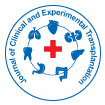Different types of skin grafts used for surgery
Received: 10-Jan-2022 / Manuscript No. jcet-22-53438 / Editor assigned: 12-Jan-2022 / PreQC No. jcet-22-53438(PQ) / Reviewed: 25-Jan-2022 / QC No. jcet-22-53438 / Revised: 31-Jan-2022 / Manuscript No. jcet-22-53438(R) / Accepted Date: 02-Feb-2022 / Published Date: 04-Feb-2022 DOI: 10.4172/2475-7640.1000124
Skin grafting is a surgery that includes believed Source eliminating skin from one region of the body and moving it to an alternate region of the body. This medical procedure might be done assuming a piece of your body has lost its defensive covering of skin because of burns, injury, or disease. Skin grafts are acted in a medical clinic. Most skin grafts include general sedation and that implies you’ll be sleeping all through the system and won’t feel any pain [1]. A skin graft is set over a region of the body where the skin has been lost. Normal purposes behind a skin graft include
• Treating profound burns.
• Eliminating injuries from a skin illness.
• Containing enormous, painful injuries.
• Treating pressure wounds or bed injuries and different ulcers on the skin.
• Skin malignant growth medical procedure.
Types of Skin Grafts
Split-thickness grafts
A split-thickness graft includes eliminating the top layer of the skin, the epidermis - as well as a part of the more profound layer of the skin called the dermis [2,3]. The specialist removes trusted Source these layers from the contributor site, which is the region where the solid skin is found. Split-thickness skin grafts regularly come from the front or external thigh, midsection, buttocks or back. Specialists utilize splitthickness grafts to cover bigger areas of harmed skin. These grafts will quite often be delicate and normally have a glossy or smooth appearance. They may likewise seem paler than the connecting skin. Split-thickness grafts don’t develop as promptly as un grafted skin, so youngsters who get them might require extra grafts as they become older.
Full-thickness grafts
A full-thickness graft involves trusted source eliminating epidermis and dermis from the donar site. Specialists as a rule take healthy skin from the mid-region, groin, lower arm, or region over the clavicle (collarbone). Specialists frequently utilize full-thickness grafts for little injuries on exceptionally noticeable pieces of the body like the face.
Dissimilar to part thickness joins, full-thickness unites mix in with the skin around them and will more often than not have a superior restorative result [4].
How to Prepare a Skin Graft
Your primary care physician will probably plan your skin graft a little while ahead of time, so have the opportunity to anticipate the medical procedure. You should plan to tell your physician early with regards to any remedy or over-the-counter medicines you’re taking, including nutrients and enhancements. Certain drugs like headache medicine can obstruct the blood’s capacity to shape clumps. Your physician might request that you change your portion or quit taking these prescriptions before the medical procedure. Furthermore, smoking or utilizing tobacco items will disable your capacity to mend following a skin graft so your physician will probably request that you quit smoking in front of your medical procedure [5]. Your primary care physician will likewise tell you not to eat or drink anything after 12 PM upon the arrival of the method. This is to keep you from heaving and gagging during the medical procedure on the off chance that the sedation sickens you. You ought to likewise anticipate bringing a relative or companion who can drive you home after the medical procedure. General sedation might make you tired after the system, so you shouldn’t drive until the impacts have completely worn off. It’s additionally smart to have somebody stay with you for the initial not many days after the medical procedure. You might require help playing out specific undertakings and getting around the house.
References
- Adams DC, Ramsey ML (2006) Grafts in dermatologic surgery: Review and update on full- and split-thickness skin grafts, free cartilage grafts, and composite grafts. Dermatol Surg 31:1055-1067.
- Webster J, Scuffham P, Stankiewicz M, Chaboyer PW (2014) Negative pressure wound therapy for skin grafts and surgical wounds healing by primary intention. Cochrane Database Syst Rev 20:50-57.
- Andreassi A, Bilenchi R, Biagioli M, Aniello CD (2005) Classification and pathophysiology of skin grafts. Clin Dermatol 23:332-337.
- Fimiani M, Pianigiani E, Simplicio FCD, Sbano P, Cuccia A (2005) Other uses of homologous skin grafts and skin bank bioproducts. Clin Dermatol 23: 396-402.
- Ameer F, Singh AK, Kumar S (2013) Evolution of instruments for harvest of the skin grafts. Indian J Plast Surg 46:28-35.
Indexed at, Google Scholar, Crossref
Indexed at, Google Scholar, Crossref
Indexed at, Google Scholar, Crossref
Indexed at, Google Scholar, Crossref
Citation: Pagano D (2022) Different Types of Skin Grafts Used For Surgery. J Clin Exp Transplant 7: 124. DOI: 10.4172/2475-7640.1000124
Copyright: © 2022 Pagano D. This is an open-access article distributed under the terms of the Creative Commons Attribution License, which permits unrestricted use, distribution, and reproduction in any medium, provided the original author and source are credited.
Select your language of interest to view the total content in your interested language
Share This Article
Recommended Journals
Open Access Journals
Article Tools
Article Usage
- Total views: 3181
- [From(publication date): 0-2022 - Dec 07, 2025]
- Breakdown by view type
- HTML page views: 2583
- PDF downloads: 598
